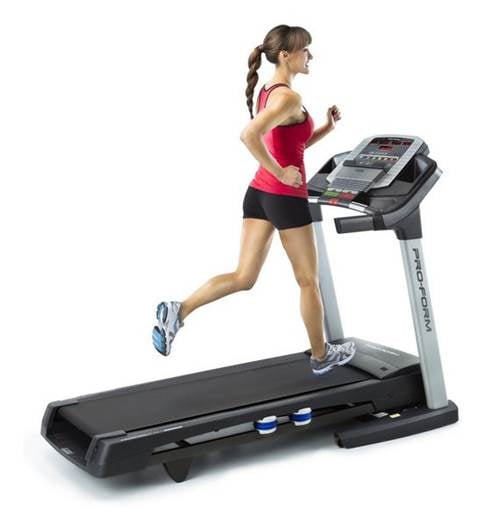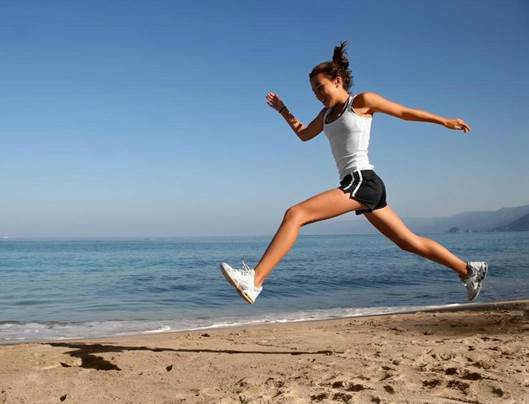When you took your first tentative steps
into the world of running, chances are you had one wish -not to pass out! But
as your experience grows, so do your expectations, and soon you’ll want to run
faster and farther. Boosting your striding skills can be tough, so we asked
seven fitness pros how you can reap your running rewards.
1.
‘Take on the treadmill’
When it’s glazed over outside, the
treadmill is a fantastic training tool. The trick is to tailor your gym
workouts to mimic outdoor conditions. ‘Without obstacles like hills and wind,
your heart rate will be lower on a treadmill,’ says Perera. ‘The treadmill also
helps propel you forward by pushing your legs, instead of you pulling them
forward, so running without an incline is similar to running on a slight
downward slope.’ Set the treadmill to an incline of one per cent to simulate
outdoor running intensity and have a better chance of adopting your natural
stride pattern.

When
it’s glazed over outside, the treadmill is a fantastic training tool.
2.
‘Stress your system’
Doing the same run every week can have an
undesired effect. Your body is pretty smart and quickly adapts to a running
routine -becoming more efficient and using less energy. This means your speed
and endurance gains level off and your running improvements dwindle. ‘To
improve as a runner, you need to overload your system by asking it to do more,’
says Baldaro. ‘This could be two miles as opposed to one, or 15 instead of 12.
The key is to increase your distance regularly.’ Mix speed and distance by
adding one-to four-minute sprints into longer runs.
3.
‘Relax a little’
Do you tense your upper body when the going
gets tough? ‘You may not realize it, but stress and tension can hinder your
forward movement,’ claims Crawford. ‘By tensing your muscles, you’ll restrict
your range of motion and then have to work harder to move your body.’ It’s
common for runners to hold tension in their shoulders, neck and arms when
tiredness sets in. Not only could this lead to injury, but it will also
contribute to fatigue and a decreased performance. If your hands start to move
towards your shoulders, drop your arms by your sides and give them a quick
shake. Also, try to keep your hands relaxed, as clenched fists will lead to
tight arms and shoulders.

‘By
tensing your muscles, you’ll restrict your range of motion and then have to
work harder to move your body.’
4.
‘Attack your abs’
Smart runners know the importance of core
work. Not only will a sturdy core help you keep a strong running form during
long runs, but it will also reduce your injury risk. ‘Running has a massive
impact on your spine. The stronger your core, the more able it is to help
absorb some of the shock of each foot-strike,’ explains Francis. ‘Try doing
exercises that work your core and improve your balance. This will help train
your neuromuscular system to adjust your stride to stop you from falling over!’
Balance boards, BOSU balls and Swiss balls all help when used in the right way.
If you’re looking for an exercise to do outside of the gym, try engaging your
core muscles and lifting one foot off the ground for 30 seconds. When you can
stand tall without wobbling, close your eyes and hold for a further 30 seconds.
Repeat on the other leg.
5.
‘Let your gaze guide you’
Several miles into a run, you may be
tempted to drop your head and look at the ground. After all, when your leg
muscles are burning, what good can come from seeing how far you are from home?
More good than you’d think, actually. ‘Looking at the ground will cause you to
slow down,’ explains Storey. ‘It has a knock-on effect further down the body,
creating a misalignment in your entire spine that leads to a deterioration in
technique. Try to relax your shoulders and look at the ground 10-20 feet in
front of you.’ Keeping your head up will also help open your airways, making it
a little easier to breathe and get much-needed oxygen to those tired muscles.
You have been told!

Try
to relax your shoulders and look at the ground 10-20 feet in front of you.
6.
‘Replace your runs’
A well-rounded running schedule doesn’t
have to mean constant pavement pounding -a plethora of research shows that
cross-training (that is, doing a different activity) can boost striding skills,
too. The secret is to replace one to two weekly run sessions with an activity
that will continue to improve your cardiovascular fitness, as well as work your
running muscles. ‘The intensity of your interval or steady-pace runs can be
replicated in the swimming pool, on a bike or cross-trainer, all of which are
nonimpact and will reduce your risk of injury,’ says Hall. ‘Weight lifting is
essential for strengthening your joints and muscles with low-impact movements.
Exercises that are perfect for runners include dead lifts and squats, as well
as split snatches and cleans.’
7.
‘Fix your form’
Running drills, such as high-knee lifts or
bounds, may not leave you gasping for air, but they will boost your running
ability by training your neuromuscular system to work efficiently. ‘Drills are
an important training tool used by athletes in all sports,’ says Nelson. ‘The
aim of a running drill is to improve your technique by focusing on one phase of
the run cycle. For example, a ‘high-knee’ drill helps improve speed by focusing
on the upward motion of the running stride.’ The good news is that a high-knee
drill is easy to do -simply walk or jog and lift each leg up high, until your
knee is almost reaching hip level. The key is to drive your knees into the air
as fast as you can, while maintaining a controlled torso and relaxed shoulder
(hint - if you're doing the exercise correctly, you won’t go very far!). Aim to
cover all elements of the run cycle, by mixing high-knee drills with another
exercise such as ‘heel flicks’. To do the heel-flick drill, run at an easy
pace. Once you’ve established a rhythm, bend your legs at the knee and bring
your lower limbs towards your rear. Your heels should flick against your bum. Easy.

The aim of a running drill is to improve
your technique by focusing on one phase of the run cycle